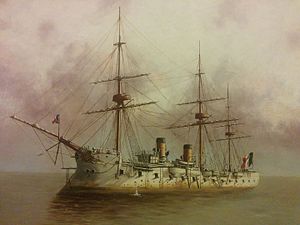French cruiser Duquesne (1876)
Appearance
 Detail of "The Duquesne" (1903), painting of the twenty-one gun French iron-hulled cruiser, by Henry E. Traumer, on display at the Duquesne Club, Pittsburgh, Pennsylvania.
| |
| History | |
|---|---|
| Name | Duquesne |
| Builder | Arsenal de Rochefort |
| Laid down | 1873 |
| Launched | 1876 |
| Stricken | 1901 |
| Fate | Scrapped |
| General characteristics | |
| Class and type | Unprotected cruiser |
| Displacement | 5,905 tonnes (5,812 long tons) |
| Length | 100.4 m (329 ft) at water level |
| Beam | 15.2 m (50 ft) |
| Draught | 7.98 m (26.2 ft) maximum |
| Speed | 16.8 knots (31.1 km/h; 19.3 mph) |
| Range | 4,400 nmi (8,100 km; 5,100 mi) at 10 kn (19 km/h; 12 mph) |
| Complement | 551 |
The French cruiser Duquesne was an unprotected cruiser built for the French Navy. It was the sixth ship in the French Navy to be named for Abraham Duquesne. The ship was laid down at Arsenal de Rochefort in 1873 and launched in 1876. It was struck in 1901.
References
- Gogin, Ivan (2014). "Duquesne Iron Unprotected Cruiser (1878)". Navypedia. Retrieved 20 November 2016.
